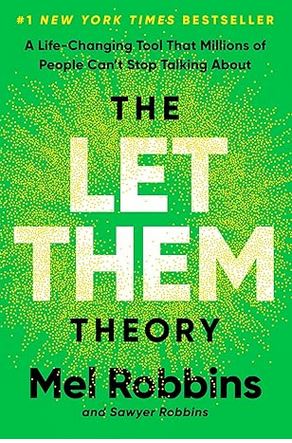
The Let Them Theory: How I Stopped Managing Everyone Else and Started Living My Life
by Mel Robbins
$28.00
⭐ 4.8 out of 5 stars (12,345+ reviews)
*As an Amazon Associate, I earn from qualifying purchases.
The Let Them Theory: How I Stopped Managing Everyone Else and Started Living My Life
A personal reflection on a viral mindset shift—why letting others be themselves gave me back my peace.
A 1,000‑word personal reflection and review of the Let Them Theory: what it means, how to practice it, and why this simple mindset can transform your peace, boundaries, and relationships.
Affiliate Disclosure: This article contains affiliate links. As an Amazon Associate, we may earn from qualifying purchases.
“Let them.” I didn’t expect two words to change my nervous system, but here we are. I found the Let Them Theory in the middle of a week where I was juggling other people’s deadlines, disappointments, and opinions like it was my full‑time job. It wasn’t. But I had been acting like the project manager of everyone else’s emotions—forecasting reactions, rehearsing explanations, picking up slack that wasn’t mine. When I heard those words—let them—something unclenched.
The idea, popularized widely by Mel Robbins, is disarmingly simple: when people show you who they are, let them. When they judge, let them. When they’re late, let them. When they choose different values, let them. Not because you don’t care, but because you finally care enough about your own peace to stop doing work that doesn’t belong to you. If you want a clear, practical guide that goes deeper into this mindset, here’s the book everyone’s talking about.
What “Let Them” Actually Means (And What It Doesn’t)
At first I mistook “letting them” for passivity. It’s not. It’s clarity. The theory is a two‑part practice: Let Them and Let Me. I accept reality as it is—what they choose, what they value—and then I pivot the saved energy into what I get to do next. Acceptance isn’t approval; it’s the end of the tug‑of‑war that was burning my hands.
- Let Them: People are sovereign. Their choices are their curriculum. I don’t need to audit the course.
- Let Me: Choose my response, set my boundary, take the next step that honors my values.
From that moment, my daily life started to feel less like a courtroom and more like a studio. Less defending, more creating.
Three Moments That Changed After “Let Them”
1) The Critic I Kept Trying to Convert
There’s always one—someone who treats your new idea like a personal inconvenience. I used to prepare PowerPoint‑level defenses for casual skepticism. Now I practice this small script: Let them think what they think. Then: Let me return to my work. The time I save—and the dignity I keep—are their own kind of victory.
2) The Habit I Couldn’t Fix for Someone Else
A person I love struggles with follow‑through. I tried reminders, charts, pep talks, the works. Nothing stuck. “Let them” didn’t make me cold; it made me honest. I stopped volunteering for consequences that weren’t mine and started setting kinder, firmer boundaries. The relationship got quieter, calmer, and strangely closer—because I wasn’t parenting a peer anymore.
3) The Group Chat That Drains the Battery
You know the one—endless debates, performative outrage, no resolution. I let them keep debating. Let me read a chapter, take a walk, or make something instead. Choosing not to perform my opinion in every arena is not withdrawal; it’s stewardship.
How to Practice It (In Real Life, Not Just Online)
- Notice the control urge. The moment I feel myself scripting someone else’s reaction, I name it. That’s my cue to breathe.
- Say the mantra. “Let them.” It’s a circuit breaker that returns my attention to what I can influence.
- Pivot to “Let Me.” What honors me here—silence, a boundary, a decision, a tiny next step? Do that.
If you’re ready for a deeper dive and step‑by‑step frameworks (with scripts, boundary language, and everyday examples), the Let Them Theory book on Amazon is a solid place to start.
Boundaries With Heart
Letting people be themselves is not the same as inviting chaos. Paradoxically, the more I practice acceptance, the clearer my lines become. “Let them be unreliable” becomes “Let me stop relying on them.” “Let them disagree” becomes “Let me stop over‑explaining.” The theory doesn’t make you a doormat; it hands you your door back, with a working lock and a welcome mat you can lift on your own terms.
“You can tap into peace and true control if you let them be themselves.”
What Changed For My Anxiety
My anxiety thrives on imaginary jobs: public relations manager for everyone’s feelings, chief story‑corrector of the internet, supervisor of all outcomes. “Let them” laid off those positions. I still care deeply; I just don’t audition for roles I don’t want. The cortisol curve flattened. Even my calendar looks different—fewer debates, more deep work; fewer apologies for existing, more simple yes/no decisions.
Who This Helps Most
- People‑pleasers and over‑functioners: If you’re exhausted from managing perceptions, this is relief with a plan.
- Parents, partners, teammates: It separates love from control so relationships can breathe.
- Creators and founders: It protects your focus from opinion storms you were never meant to chase.
Common Misunderstandings
“If I let them, won’t things get worse?” Sometimes they do, briefly—because reality stops being cushioned by your over‑functioning. But clarity is kinder than quiet resentment. You also get clean data about who belongs in close proximity to your life.
“Isn’t this just avoidance?” Avoidance hides. Acceptance acts. It says, “I see what’s happening; here’s my response.”
A Tiny Script for Everyday Peace
Next time your phone lights up with a take that invites a spiral, try this:
- Let them post it.
- Let me put the phone down, drink water, and decide if responding serves my values.
This two‑step has saved whole afternoons.
If You Want a Guidebook
I’m a fan of tools I can open on stressful days and say, “Remind me how to do this.” If that’s you too, this book is a great companion. It expands the idea with examples, scripts, and gentle challenges that make the practice stick.
Final Note: The Day I Felt Different
The first time I noticed a shift, nothing dramatic happened. A friend canceled plans—again. I typed half a paragraph about respect, then paused. Let them. I went for a walk, bought flowers, and cooked something simple. The evening felt unremarkable and quietly perfect. Ordinary peace—that’s what the Let Them Theory gave back.
Disclosure: As an Amazon Associate, Mind Garden Press may earn from qualifying purchases made through links on this page. Your support helps us keep making thoughtful, ad‑light content.









